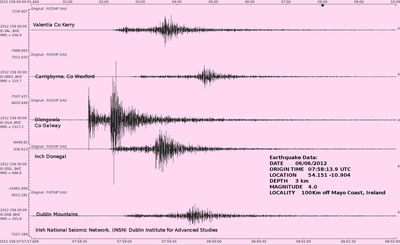Map of Euro-Med earthquakes in the past 24 hours, including the one off Ireland's Mayo coastline on 6 June 2012. Credit: European-Mediterranean Seismological Centre (EMSC)
This morning’s magnitude 4 earthquake off Ireland’s Co Mayo coastline was picked up by the newly installed seisometer on Cliffs of Moher in Co Clare. The tremor was recorded at a depth of three kilometres, and it was the second significant earthquake to hit the west of Ireland in recent years, according to the Irish National Seismic Network.
Earlier today the British Geological Society had confirmed that the magnitude 4 earthquake had struck 60km off the Co Mayo coastline at 8.58am.
David Galloway, a seismologist with the British Geological Survey, said that the earthquake had a magnitude of 4 but that there had been no reports of damage.
He said that people in the counties of Mayo, Sligo and Galway had experienced tremors as a result of the unusual seismic event for Ireland.
“We’ve had no reports of damage, apart from some rattling of windows. People have said the sensation felt like a lorry going into the side of a house or a steamroller going down the road,” said Galloway.
Back in May 2010, a 2.7-magnitude earthquake in Lisdoonvarna remains the strongest onshore earthquake recorded in Ireland since records began in 1978.
Tom Blake, Irish National Seismic Network (INSN) director and experimental officer with the School of Cosmic Physics at the Dublin Institute for Advanced Studies (DIAS), said today’s earthquake was the first event recorded in this area and was felt onshore by quite a number of people.
“There are some reports of minor structural damage, which have not been confirmed,” he said.
The largest earthquake that was ever felt in Ireland happened on 19 July 1984 with a magnitude of 5.4. The earthquake itself happened off the coast of Wales, but it also caused minor structural damage on Ireland’s east coast.
“Although Ireland does not sit on any major plate margin, it is still susceptible to earthquakes as we saw in Mayo today and in Clare in 2010. The Cliffs of Moher seismometer was well placed to register and record this week’s earthquake. This was a very important seismic event as it was the first time that a tremor had occurred in this region since records began.”

The seismic waves generated by today’s earthquake was recorded by the INSN at its stations in Donegal, Dublin, Galway, Wexford and Kerry
The DIAS began modern seismic recordings in 1978. Meanwhile the INSN now has five permanent stations in Dublin, Kerry, Galway, Donegal and Wexford, along with 55 other seismometers around the country.
Visitors to the exhibition centre at the Cliffs of Moher can also experience its seisometer in action, said director Katherine Walker.
“We are delighted that the Burren and Cliffs of Moher Geopark is now part of a potential European Geopark seismic network, something which is being promoted by Tom Blake,” she said.